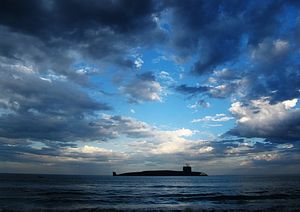Will INS Arihant and her sisters provide stability in South Asia, or increase the dangers of a crisis? A recent article in the Washington Quarterly suggests the latter. Diana Wueger argues that, contrary to the experience of the Cold War, the development of a sea-based deterrent will probably not contribute to the stability of the South Asian nuclear balance. Instead, it could lead to a dangerous spiral between India and Pakistan, or between India and China.
It’s worth thinking about what the Indian Navy expects the Arihant-class to do. In traditional deterrence terms, Arihant provides insurance against a disarming or decapitating nuclear strike launched by either China or Pakistan. China surely has sufficient weapons and delivery systems to carry out such a strike, possibly in a very short time frame, and potentially using its own nuclear-powered ballistic missile submarines (SSBNs) in the process. Pakistan’s expanding nuclear arsenal could also put India’s command and control systems at considerable risk in a general attack.
Wueger expresses several concerns. First, she worries that the specific dynamics of India’s deterrent relationships don’t demand the development of an SSBN force; India can manage without and boomers take away from other naval priorities. She also worries that an expansion of India’s SSBN force — and potentially the creation of Pakistan’s — will drive a destabilizing anti-submarine warfare (ASW) race in the Indian Ocean. The Cold War saw precisely this development, as both the United States and the USSR redoubled their investment in ASW as SSBNs became more capable. China’s ASW capabilities have already begun to grow more formidable, just as the PLAN has devoted greater attention to the Indian Ocean.
The Arihant could also throw off the already tenuous crisis-management dynamics between India and Pakistan. In particular, Pakistan might seek to develop its own sea-based deterrent, only without the economic and technical resources that India has on command. This could result in Pakistani diesel-electrics carrying nuclear-armed cruise missiles, an outcome that would have deeply destabilizing effects on crisis scenarios.
In short, Wueger suggests that SSBNs do no transform the deterrent relationship between China and India (although they do introduce a new arena for competition), and that they have the potential to destabilize the already problematic Indo-Pakistani relationship. Unfortunately, it’s far too late for India to change its mind; Arihant is conducting trials, and the rest of the class will hit the sea over the next decade. Over the long run, however, the Indian Navy may regret the investment in a class of subs designed to do nothing other than hide at the bottom of the ocean, instead of concentrating on more practical, useful vessels.

































